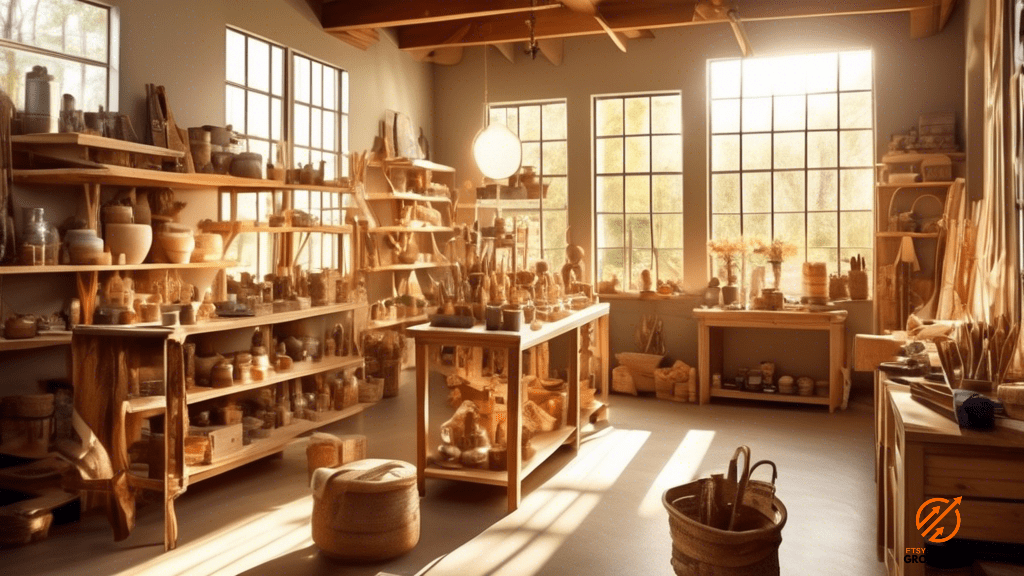Implementing Tiered Pricing Models For Your Handmade Products
by Kevin Fairbanks · February 9, 2024
Unlock the secrets of tiered pricing models for your handmade products and watch your profits soar! Learn how to attract loyal customers and increase sales today. Click here to start maximizing your profits!
Are you a maker of handmade products looking to maximize your profits and attract a wider range of customers? Implementing tiered pricing models for your handmade products could be the solution you’ve been searching for.
By offering different pricing tiers for different product levels, you can cater to a variety of customers while also increasing the perceived value of your products.
In this article, we will guide you through the process of implementing tiered pricing models for your handmade products.
We will start by helping you understand what tiered pricing models are and how they can benefit your business.
Next, we will discuss how to determine the categories of your products and set pricing tiers accordingly.
We will also provide tips on effectively communicating the value of each tier to your customers.
Finally, we will explain the importance of monitoring and adjusting your pricing strategy to ensure ongoing success.
So, let’s dive in and learn how to implement tiered pricing models for your handmade products to boost your sales and profitability.
Key Takeaways
- Regularly assess pricing strategy
- Look for patterns and trends
- Adjust pricing tiers to remain competitive
- Revise pricing strategy if necessary
Understanding Tiered Pricing Models
Now that you’ve grasped the concept of tiered pricing models, it’s time to delve deeper into the intricacies and complexities that come with understanding them.
Tiered pricing models are a strategic way to offer different pricing options for your handmade products, based on factors such as quantity, quality, or customization. These models allow you to cater to a wider range of customers with varying needs and budgets.
One key aspect of understanding tiered pricing models is determining the tiers themselves. You need to identify the different levels or categories that will exist within your pricing structure. For example, if you sell handmade jewelry, your tiers could be based on the materials used, the complexity of the design, or the level of customization. By defining these tiers, you can effectively communicate the value proposition of each level to your customers.
Another important factor to consider is pricing differentiation. Each tier should offer a different level of value or benefit to justify the price difference. This could mean using higher quality materials or offering additional services or features for higher-priced tiers. It’s essential to strike a balance between cost and perceived value to ensure that customers feel they’re getting a fair deal at each tier.
Understanding tiered pricing models also requires analyzing customer behavior and market demand. You need to identify the pricing sweet spot for each tier, where customers are willing to pay the price for the value they receive. This may involve conducting market research, analyzing competitor pricing, and gathering customer feedback.
In conclusion, understanding tiered pricing models goes beyond simply grasping the concept. It involves carefully defining tiers, differentiating value, and analyzing market demand. By implementing tiered pricing models for your handmade products, you can cater to a wider range of customers and maximize your revenue potential.
Determining Your Product Categories
When categorizing your products, consider the different types and variations you offer. This will help you determine the categories that best fit your products and allow you to implement a tiered pricing model effectively.
Start by identifying the main types or groups that your products fall into. For example, if you sell handmade jewelry, you might have categories such as necklaces, bracelets, earrings, and rings. Within each category, think about the different variations or styles you offer. This could include different materials, designs, or sizes. By breaking down your products into these categories and variations, you can create a pricing structure that reflects the value and complexity of each item.
Once you have determined your product categories, you can assign different price tiers to each category based on factors such as materials used, time and effort required to create the item, and market demand. For example, you might decide to have a basic tier for simpler designs or materials, a mid-tier for more intricate or time-consuming pieces, and a premium tier for high-end materials or limited edition items.
This tiered pricing approach allows you to cater to different customer segments and capture a wider range of customers. It also gives your customers the option to choose the level of quality and exclusivity they desire, which can increase their satisfaction and willingness to pay for your products. Consider experimenting with different pricing tiers to find the right balance between profitability and customer demand for each category.
Setting Pricing Tiers for Different Product Levels
To set pricing tiers for your different product levels, begin by considering the quality and complexity of each item. Higher quality products that require more skill and time to create should be priced at a higher tier. This not only reflects the value and effort put into the product but also allows you to cover the costs associated with producing it.
On the other hand, products that are less complex or of lower quality can be priced at a lower tier. Next, take into account the materials used in each product. If you’re using premium or expensive materials for certain items, it makes sense to set a higher price for them. Customers are often willing to pay more for products made with high-quality materials. However, if you’re using more affordable materials for other items, you can set a lower price to attract a wider range of customers.
Additionally, consider the demand and market competition for each product. If a particular item is in high demand and there’s limited competition, you can set a higher price for it. However, if there are many similar products available in the market or if the demand is low, it may be more appropriate to set a lower price to attract customers.
By carefully evaluating the quality, complexity, materials, and market demand for each of your handmade products, you can effectively set pricing tiers that reflect their value and appeal to a wide range of customers. Remember to regularly review and adjust your pricing tiers based on market trends and customer feedback to ensure your handmade products remain competitive and profitable.
Communicating the Value of Each Tier
Discover the best way to effectively convey the unique value of each tier in your pricing strategy. When it comes to communicating the value of each tier in your pricing model, it’s important to clearly highlight the benefits and features that differentiate each level. One effective way to do this is by creating a table that compares the different tiers side by side. This table can include columns for the tier name, price, features, and benefits. By presenting this information in a clear and concise manner, you can help potential customers understand the value they will receive at each tier and make an informed purchasing decision.
For example, let’s say you offer three tiers for your handmade products: basic, standard, and premium. In the table, you can list the price for each tier, along with the specific features and benefits that come with it. The basic tier could include the lowest price point and offer a limited set of features, while the premium tier could have a higher price point and include additional features and benefits such as faster shipping or personalized customization options. By presenting this information in a table format, customers can easily compare the different tiers and see the value they will receive at each level. This can help them make a decision based on their budget and the specific features they are looking for in a product.
Monitoring and Adjusting Your Pricing Strategy
Keep a close eye on your pricing strategy by monitoring and adjusting it regularly, as studies have shown that businesses that regularly review and make changes to their pricing increase their profitability by an average of 2-4%.
By regularly monitoring and adjusting your pricing strategy, you can ensure that you are staying competitive in the market and maximizing your profits.
Here are some key steps to help you effectively monitor and adjust your pricing strategy:
- Analyze your costs: Regularly review your costs to ensure that your pricing strategy aligns with your expenses. Consider factors such as the cost of materials, labor, and overhead. By understanding your costs, you can make informed decisions about your pricing tiers.
- Monitor customer feedback: Pay attention to customer feedback and reviews to gauge how your pricing strategy is resonating with your target audience. If customers consistently mention that your prices are too high or too low, it may be a sign that adjustments need to be made.
- Keep an eye on the competition: Stay informed about your competitors’ pricing strategies. If you notice that they are offering similar products at lower prices, it may be necessary to adjust your pricing tiers to remain competitive.
- Track sales and profitability: Regularly track your sales and profitability to assess the effectiveness of your pricing strategy. Look for patterns and trends that may indicate the need for adjustments. For example, if you notice a decline in sales or a decrease in profitability, it may be a sign that your pricing strategy needs to be revised.
By following these steps and regularly monitoring and adjusting your pricing strategy, you can ensure that your handmade products are priced competitively and maximize your profitability.
Frequently Asked Questions
How can I determine the optimal number of pricing tiers for my handmade products?
To determine the optimal number of pricing tiers for your handmade products, analyze your target market and competitors. Consider their preferences and price sensitivity. Conduct market research and test different pricing strategies to find the most effective approach.
What factors should I consider when setting prices for each tier?
When setting prices for each tier, consider the demand, production costs, and perceived value of your handmade products. Like a sculptor molding clay, find the perfect balance that captures the essence of profitability and customer satisfaction.
Are there any specific marketing strategies that can help me effectively communicate the value of each tier to customers?
To effectively communicate the value of each tier to customers, consider highlighting the unique features and benefits of each tier. Use persuasive language, testimonials, and visual elements to showcase the value and justify the pricing differences.
How often should I review and adjust my pricing strategy?
You should regularly review and adjust your pricing strategy to ensure it aligns with market trends, production costs, and customer demand. By consistently evaluating and adapting, you can maximize profitability and stay competitive.
Are there any potential drawbacks or risks associated with implementing a tiered pricing model for handmade products?
The potential drawback of implementing a tiered pricing model for your handmade products is that some customers may feel excluded or undervalued if they cannot afford the higher-priced tiers.
Last Updated: January 22, 2024
Disclosure: We may receive affiliate compensation for some of the links in this article at no additional cost to you if you decide to purchase a product. You can read our affiliate disclosure in our privacy policy.
Kevin Fairbanks is your expert navigator in the world of Etsy business. With a passion for creativity and a deep understanding of the e-commerce landscape, Kevin brings a wealth of knowledge to aspiring and established Etsy sellers alike.
As a seasoned entrepreneur and successful owner of multiple Etsy shops, Kevin knows firsthand the challenges and triumphs of the Etsy marketplace. His journey is one of innovation, perseverance, and a keen eye for market trends, making him an invaluable guide for anyone looking to succeed on Etsy.
Kevin’s expertise extends beyond just shop management; he is adept in areas such as SEO optimization, effective marketing strategies, and financial planning for online businesses. His insights are grounded in real-world experience, offering practical and actionable advice.
Join Kevin as he shares his journey and expertise on Etsy Growth Hub. Whether you’re starting your first Etsy shop or looking to expand your existing business, Kevin’s guidance is designed to help you navigate the complexities of Etsy selling with confidence and creativity.
Stay tuned with Kevin’s latest strategies and tips on Etsy Growth Hub to transform your passion into a thriving online business. His dedication to empowering Etsy sellers is evident in every piece of advice he shares, helping you turn your Etsy dreams into reality.
Verified and Approved by:

Kevin Fairbanks
Head of SEO
Like This Article?
Share with your friends
Table of Contents
Latest Articles
Keep Reading
-
Building Strong Customer Relationships
Learn the proven strategies to establish lasting customer connections and skyrocket your business with our guide on building strong customer relationships. Click now for expert tips and techniques to win customer loyalty and drive success.
-
Collaborating With Influencers To Boost Your Etsy Shop’s Visibility
Boost your Etsy shop’s visibility and sales with influencer collaborations. Learn how to skyrocket your business in this game-changing strategy. Don’t miss out, click here now!
-
Making The Most Of Instagram Live For Your Etsy Shop
Boost your Etsy shop’s success with these Instagram Live tips! Learn how to engage and connect with your audience like never before. Don’t miss out on this opportunity to take your business to the next level. Click here now!




